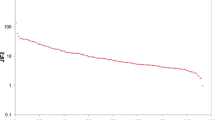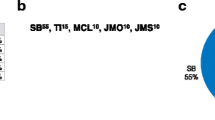Abstract
Leaders are important for scientific groups. Authors of a research paper whose names are listed in the byline first, last, or as the corresponding author are often considered particularly important to that paper. The authorship preferences of scientific group leaders are examined for seven research fields and 11 geographic locations. There are some similarities and differences among research fields and geographic locations in listing group leaders. In the fields of “Mathematics” and “Physics, Particles & Fields”, although the custom is for papers to list authors alphabetically, scientific group leaders from Egypt and Shanghai typically list their names first or last in the byline, the same as group leaders in other research fields. Opposite to the group leaders from other locations, leaders from Egypt often appear as the first authors. Scientific group leaders who are listed first in the byline typically also serve as the corresponding authors. For group leaders who are listed last in the byline, the proportion also serving as corresponding authors changes significantly. Accordingly, the proportion of papers in which group leaders are corresponding authors varies considerably among different research fields and geographic locations. The meaning of authorship for research group leaders is discussed in the end from the perspective of their roles in paper production.


Similar content being viewed by others
References
Akhabue, E., & Lautenbach, E. (2010). “Equal” contributions and credit: An emerging trend in the characterization of authorship. Annals of Epidemiology, 20(11), 868–871.
Amabile, T. M., Conti, R., Coon, H., Lazenby, J., & Herron, M. (1996). Assessing the work environment for creativity. Academy of Management Journal, 39(5), 1154–1184.
Bates, T., Anić, A., Marušić, M., & Marušić, A. (2004). Authorship criteria and disclosure of contributions. Comparison of 3 general medical journals with different author contribution forms. The Journal of the American Medical Association, 292(1), 86–88.
Bennett, D. M., & Taylor, D. D. (2003). Unethical practices in authorship of scientific papers. Emergency Medicine, 15(3), 263–270.
Beveridge, C., & Morris, S. (2007). Order of merit. Nature, 448(7152), 508.
Bhandari, M., Busse, J. W., Kulkarni, A. V., Devereaux, P. J., Leece, P., & Guyatt, G. H. (2004). Interpreting authorship order and corresponding authorship. Epidemiology, 15(1), 125–126.
Bhopal, R., Rankin, J., McColl, E., Thomas, L., Kaner, E., & Stacy, R., et al. (1997). The vexed question of authorship: views of researchers in a British medical faculty. British Medical Journal, 314(7086), 1009–1012.
Biagioli, M. (1998). The instability of authorship: credit and responsibility in contemporary biomedicine. FASEB Journal, 12(1), 3–16.
Birnholtz, J. P. (2006). What does it mean to be an author? The intersection of credit, contribution, and collaboration in science. Journal of the American Society for Information Science and Technology, 57(13), 1758–1770.
Buehring, G. C., Buehring, J. E., & Gerard, P. D. (2007). Lost in citation: Vanishing visibility of senior authors. Scientometrics, 72(3), 459–468.
Costas, R., & Bordons, M. (2011). Do age and professional rank influence the order of authorship in scientific publications? Some evidence from a micro-level perspective. Scientometrics, 88(1), 145–161.
Cronin, B. (2001). Hyperauthorship: A postmodern perversion or evidence of a structural shift in scholarly communication practices? Journal of the American Society for Information Science and Technology, 52(7), 558–569.
Cronin, B., & Franks, S. (2006). Trading cultures: Resource mobilization and service rendering in the life sciences as revealed in the journal article’s paratext. Journal of the American Society for Information Science and Technology, 57(14), 1909–1918.
Dance, A. (2012). Authorship: Who’s on first? Nature, 489, 591–593.
Dotson, B., & Slaughter, R. L. (2011). Prevalence of articles with honorary and ghost authors in three pharmacy journals. American Journal of Health-System Pharmacy, 68(18), 1730–1734.
Drenth, J. P. H. (1998). Multiple authorship. The contribution of senior authors. The Journal of the American Medical Association, 280(3), 219–221.
Egghe, L., Rousseau, R., & Van Hooydonk, G. (2000). Methods for accrediting publications to authors or countries: Consequences for evaluation studies. Journal of the American Society for Information Science, 51(2), 145–157.
Etzioni, A. (1961). A comparative analysis of complex organizations. Glencoe: Free Press.
Ford, C. M. (1996). A theory of individual creative action in multiple social domains. Academy of Management Review, 21(4), 1112–1142.
Frandsen, T. V., & Nicolaisen, J. (2010). What is in a name? Credit assignment practices in different disciplines. Journal of Informetrics, 4(4), 608–617.
Gasparyan, A. Y., Ayvazyan, L., & Kitas, G. D. (2013). Authorship problems in scholarly journals: considerations for authors, peer reviewers and editors. Rheumatology International, 33(2), 277–284.
Gingras, Y., Lariviere, V., Macaluso, B., & Robitaille, J. P. (2008). The effects of aging on researchers’ publication and citation patterns. PLoS One, 3(12), e4048.
Hara, N., Solomon, P., Kim, S. L., & Sonnenwald, D. H. (2003). An emerging view of scientific collaboration: scientists’ perspectives on collaboration and factors that impact collaboration. Journal of the American Society for Information Science and Technology, 54(10), 952–965.
Hemlin, S. (2006). Creative knowledge environments for research groups in biotechnology. The influence of leadership and organizational support in universities and business companies. Scientometrics, 67(1), 121–142.
Hemlin, S., & Gustafson, M. (1996). Research production in the arts and humanities. A questionnaire study of factors influencing research performance. Scientometrics, 37(3), 417–432.
Hu, X. J. (2009). Loads of special authorship functions: Linear growth in the percentage of ‘equal first authors’ and corresponding authors. Journal of the American Society for Information Science and Technology, 60(11), 2378–2381.
Hu, X. J., Rousseau, R., & Chen, J. (2010). In those fields where multiple authorship is the rule, the h-index should be supplemented by role-based h-indices. Journal of Information Science, 36(1), 73–85.
IWCSA Report. (2012). Report on the international workshop on contributorship and scholarly attribution, May 16, 2012. Harvard University and the Wellcome Trust.
Jones, J. W., McCullough, L. B., & Richman, B. W. (2005). The ethics of bylines: Would the real authors please stand up? Journal of Vascular Surgery, 42(4), 816–818.
Kosmulski, M. (2012). The order in the lists of authors in multi-author papers revisited. Journal of Informetrics, 6(4), 639–644.
Laurance, W. F. (2006). Second thoughts on who goes where in author lists. Nature, 442(7098), 26.
Liu, X. Z., & Fang, H. (2012). Fairly sharing the credit of multi-authored papers and its application in the modification of h-index and g-index. Scientometrics, 90(1), 37–49.
Martin, B. R., & Skea J. E. F. (1992). Academic research performance indicators: An assessment of the possibilities. Science Policy Research Unit, University of Sussex, Brighton.
Mattsson, P., Sundberg, C. J., & Laget, P. (2011). Is correspondence reflected in the author position? A bibliometric study of the relation between corresponding author and byline position. Scientometrics, 87(1), 99–105.
Mumford, M. D., Scoot, G. M., Gaddis, B., & Strange, J. M. (2002). Leading creative people: Orchestrating expertise and relationhips. The Leadership Quarterly, 13(6), 705–750.
Nagpaul, P. S., & Gupta, S. P. (1989). Effect of professional competence, managerial role and status of group leaders to R&D performance. Scientometrics, 17(3–4), 301–331.
Over, R., & Smallman, S. (1970). Citation idiosyncrasies. Nature, 228(5278), 1357.
Pelz, D., & Andrews, F. (1966). Scientists in organisations: Productive climates for research and development. New York: Wiley.
Pudovkin, A., Kretschmer, H., Stegmann, J., & Garfield, E. (2010). Research evaluation. Part I: Productivity and citedness of a German medical research institution. Scientometrics, 93(1), 3–16.
Rennie, D., Yank, V., & Emanuel, L. (1997). When authorship fails: A proposal to make contributors accountable. The Journal of the American Medical Association, 278(7), 579–585.
Riesenberg, D., & Lundberg, G. D. (1990). The order of authorship: Who’s on the first. The Journal of the American Medical Association, 264(14), 1857.
Savitz, D. A. (1999). What can we infer from author order in epidemiology? American Journal of Epidemiology, 149(5), 401–403.
Shapiro, D. W., Wenger, N. S., & Shapiro, M. F. (1994). The contributions of authors to multiauthored biomedical research papers. The Journal of the American Medical Association, 271(6), 438–442.
Strotmann, A., & Zhao, D. (2012). Author name disambiguation: What difference does it make in author-based citation analysis? Journal of the American Society for Information Science and Technology, 63(9), 1820–1833.
Tao, T. Z., Bo, L. L., Wang, F., Li, J. B., & Deng, X. M. (2012). Equal contributions and credit given to authors in anesthesiology journals during a 10-year period. Scientometrics, 91(3), 1005–1010.
Tscharntke, T., Hochberg, M. E., Rand, T. A., Resh, V. H., & Krauss, J. (2007). Author sequence and credit for contributions in multiauthored publications. PLoS Biology, 5(1), e18.
Vinther, S., & Rosenberg, J. (2012). Appearance of ghost and gift authors in Ugeskrift for Laeger and Danish Medical Journal. Danish Medical Journal, 59(5), A4455.
Waltman, L. (2012). An empirical analysis of the use of alphabetical authorship in scientific publishing. Journal of Informetrics, 6(4), 700–711.
Wang, F., Tang, L., Bo, L. L., Li, J. B., & Deng, X. M. (2012). Equal contributions and credit given to authors in critical care medicine journals during a 10-yr period. Critical Care Medicine, 40(3), 967–969.
Williams, W. M., & Yang, L. T. (1999). Organisational creativity. In R. J. Sternberg (Ed.), Handbook of creativity (pp. 373–391). Cambridge: Cambridge University Press.
Woodman, R. W., Sawyer, J. E., & Griffin, R. W. (1993). Toward a theory of organizational creativity. Academy of Management Review, 18(2), 293–321.
Wren, J. D., Kozak, K. Z., Johnson, K. R., Deakyne, S. J., Schilling, L. M., & Dellavalle, R. P. (2007). The write position. EMBO Reports, 8(11), 988–991.
Yank, V., & Rennie, D. (1999). Disclosure of researcher contributions: A study of original research articles in The Lancet. Annals of International Medicine, 130(8), 661–670.
Zhang, C. T. (2009). A proposal for calculating weighted citations based on author rank. EMBO Reports, 10(5), 416–417.
Zhao, D., & Strotmann, A. (2011). Counting first, last, or all authors in citation analysis: A comprehensive comparison in the highly collaborative stem cell research field. Journal of the American Society for Information Science and Technology, 62(4), 654–676.
Zuckermann, H. (1968). Patterns of name-ordering among authors of scientific papers: A study of social symbolism and its ambiguity. American Journal of Sociology, 74(3), 276–291.
Acknowledgments
The authors thank the anonymous reviewers for useful suggestions improving this contribution. This work was supported by the National Basic Research Program of China under Grant 2011CBA00107. A Project Funded by the Priority Academic Program Development of Jiangsu Higher Education Institutions.
Author information
Authors and Affiliations
Corresponding author
Rights and permissions
About this article
Cite this article
Liu, X.Z., Fang, H. Scientific group leaders’ authorship preferences: an empirical investigation. Scientometrics 98, 909–925 (2014). https://doi.org/10.1007/s11192-013-1083-8
Received:
Published:
Issue Date:
DOI: https://doi.org/10.1007/s11192-013-1083-8




